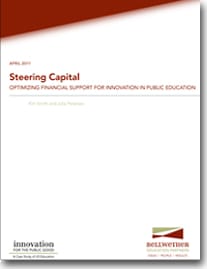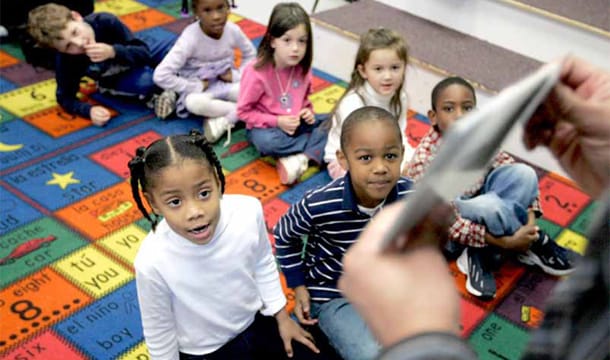
The Condition of Education 2011
Data, data, everywhere?and not a Catholic school to spare

Data, data, everywhere?and not a Catholic school to spare









 This latest portrait of American education from the
National Center for Education Statistics is, as usual, dense with useful
information. Perhaps most interesting are the large shifts on the school-choice
front, with charter enrollment ballooning and private-school enrollment losing
air. Over the past decade, the number of public charter-school pupils more than
quadrupled—from 340,000 students in 1999-2000 to 1.4 million students in
2008-09. At the same time, private-school enrollment has deflated. While these
schools taught 6.3 million students in 2001-02, private schools educated 5.5 million
youngsters in 2009-10—a 13 percent decrease. Intriguingly, the pattern varied
by school type. While enrollment in independent and secular private schools
remained constant, religious schools saw sharp declines. Catholic schools were,
once again, hit the hardest. Some other findings come as no shock (though maybe
they should): Total per-pupil expenditures rose by 39 percent (in constant
dollars) from 1989-90 to 2007-08, for example. On the good-news front, drop-out
rates have declined for whites, blacks, and Hispanics over the past thirty
years. Along with its parsed K-12 data, this year’s edition focuses on
postsecondary education, documenting significant increases in total college
enrollment and degrees as well as a bump in for-profit postsecondary enrollment
(from 3 percent in 2000-01 to 9 percent today). In total, higher-education
enrollment now trumps that of high schools: The nation boasted 17.6 million
undergraduates in the fall of 2009 (and 2.9 million postbac students) and 15
million high schoolers (in 2008-09). Choose a preferred topic, dive in, and get
a little nerdy.
This latest portrait of American education from the
National Center for Education Statistics is, as usual, dense with useful
information. Perhaps most interesting are the large shifts on the school-choice
front, with charter enrollment ballooning and private-school enrollment losing
air. Over the past decade, the number of public charter-school pupils more than
quadrupled—from 340,000 students in 1999-2000 to 1.4 million students in
2008-09. At the same time, private-school enrollment has deflated. While these
schools taught 6.3 million students in 2001-02, private schools educated 5.5 million
youngsters in 2009-10—a 13 percent decrease. Intriguingly, the pattern varied
by school type. While enrollment in independent and secular private schools
remained constant, religious schools saw sharp declines. Catholic schools were,
once again, hit the hardest. Some other findings come as no shock (though maybe
they should): Total per-pupil expenditures rose by 39 percent (in constant
dollars) from 1989-90 to 2007-08, for example. On the good-news front, drop-out
rates have declined for whites, blacks, and Hispanics over the past thirty
years. Along with its parsed K-12 data, this year’s edition focuses on
postsecondary education, documenting significant increases in total college
enrollment and degrees as well as a bump in for-profit postsecondary enrollment
(from 3 percent in 2000-01 to 9 percent today). In total, higher-education
enrollment now trumps that of high schools: The nation boasted 17.6 million
undergraduates in the fall of 2009 (and 2.9 million postbac students) and 15
million high schoolers (in 2008-09). Choose a preferred topic, dive in, and get
a little nerdy.
| Click to listen to commentary on the Condition of Education from the Education Gadfly Show podcast |
|
Susan Aud, William Hussar, Grace Kena, Kevin Bianco, Lauren Frohlich, Jana Kemp, Kim Tahan, Katie Mallory, Thomas Nachazel, and Gretchen Hannes, “The Condition of Education 2011,” (Washington, D.C.: National Center for Education Statistics, May 2011). |

 Innovation is a buzzword in many ed-reform
circles nowadays—with its presumed capacity to alter, upend, and replace
familiar systems that aren’t working well. To disrupt the status quo requires
cold, hard cash placed in the right hands, however. Bellwether Education’s new report
articulates the financial barriers to educational innovation, focusing on the “irrational,
idiosyncratic” world of education philanthropy; public policies that crowd out
entrepreneurs; and an overall shortage of investment in R&D and technology
in the education world. Offering alternative perspectives and approaches, the
authors look at trends in other sectors and analyze the key elements of
effective social-capital markets. Successes seem to hinge on public-, private-,
and philanthropic-sector collaboration, particularly in creating diverse
sources of investment capital, focusing on metrics and evidence instead of
compliance, and providing a healthy dose of transparent, useful data. Bellwether’s
offering has some affinities with a
recent paper by Kristi Kimball and Malka Kopell in the Stanford Social Innovation Review, which argues that foundations
should fund a broader portfolio of solutions to social problems and engage in
less micromanagement of the projects they support. You’ll find no arguments
from us against this kind of “tight-loose” approach to education philanthropy.
Innovation is a buzzword in many ed-reform
circles nowadays—with its presumed capacity to alter, upend, and replace
familiar systems that aren’t working well. To disrupt the status quo requires
cold, hard cash placed in the right hands, however. Bellwether Education’s new report
articulates the financial barriers to educational innovation, focusing on the “irrational,
idiosyncratic” world of education philanthropy; public policies that crowd out
entrepreneurs; and an overall shortage of investment in R&D and technology
in the education world. Offering alternative perspectives and approaches, the
authors look at trends in other sectors and analyze the key elements of
effective social-capital markets. Successes seem to hinge on public-, private-,
and philanthropic-sector collaboration, particularly in creating diverse
sources of investment capital, focusing on metrics and evidence instead of
compliance, and providing a healthy dose of transparent, useful data. Bellwether’s
offering has some affinities with a
recent paper by Kristi Kimball and Malka Kopell in the Stanford Social Innovation Review, which argues that foundations
should fund a broader portfolio of solutions to social problems and engage in
less micromanagement of the projects they support. You’ll find no arguments
from us against this kind of “tight-loose” approach to education philanthropy.
|
Kim Smith and Julie Petersen, “Steering Capital: Optimizing Financial Support for Innovation in Public Education,” (Washington, D.C.: Bellwether Education Partners, April 2011). |

 The growth of high-performing charter schools—and their charter-management organizations (CMOs)—is critical for such schools to
become sound alternatives for additional needy kids. To expand, however, CMOs must overcome
the challenge of finding superior teachers and school leaders. To see how this
has been done and can be done, this Center for American Progress report profiles
Green Dot, IDEA Public Schools, High Tech High, KIPP, Rocketship Education, and
Yes Prep and explains how they have dealt with organizational growth and
human-capital challenges. It seems that these successful CMOs have three things
in common: They formalize recruitment, training, and support processes and infrastructure;
they get the most mileage from available talent by narrowing and
better-defining staff roles; and they import and induct management talent. Toward
that end, many of these organizations have developed their own recruiting tools
and candidate evaluations. Some offer extensive professional development aligned
with their organizational cultures. Most believe in cultivating in-house talent,
often by identifying future school leaders during the teacher-hiring process. Others
have created and implemented their own certification programs. Well worth your
attention, whether or not you’re a CMO junkie.
The growth of high-performing charter schools—and their charter-management organizations (CMOs)—is critical for such schools to
become sound alternatives for additional needy kids. To expand, however, CMOs must overcome
the challenge of finding superior teachers and school leaders. To see how this
has been done and can be done, this Center for American Progress report profiles
Green Dot, IDEA Public Schools, High Tech High, KIPP, Rocketship Education, and
Yes Prep and explains how they have dealt with organizational growth and
human-capital challenges. It seems that these successful CMOs have three things
in common: They formalize recruitment, training, and support processes and infrastructure;
they get the most mileage from available talent by narrowing and
better-defining staff roles; and they import and induct management talent. Toward
that end, many of these organizations have developed their own recruiting tools
and candidate evaluations. Some offer extensive professional development aligned
with their organizational cultures. Most believe in cultivating in-house talent,
often by identifying future school leaders during the teacher-hiring process. Others
have created and implemented their own certification programs. Well worth your
attention, whether or not you’re a CMO junkie.
|
Christi Chadwick and Julie Kowal, “Preparing for Growth: Human Capital Innovations in Public Charter Schools,” (Washington, D.C.: Center for American Progress, May 2011). |



Photo by Ashley Good
Fordham’s recent look at data trends in special-education populations peered under the surface of special-ed funding—but it couldn’t dive fully into those murky waters. But with some states ostensibly spending two or three times as much per student as others, it would appear that savings can be found in this $110 billion-plus lake of school spending—without negatively impacting kids. To that end, some districts are now turning to private companies, like Futures Education, to provide quality services to disabled youngsters at a lower cost. Such firms can play a dual role. First, they are more flexible than public-school districts at providing services where and when they’re needed, hiring and retaining only the staff necessary to serve the present pupil population. If a district employs ten speech therapists on staff, it must find ways (and salaries) to keep all ten busy. A private company that hires contractors, on the other hand, can stay lean and mean. Second, because these firms are somewhat removed from the difficult politics of special ed, they may have more courage—and ability—to say no to unneeded or ineffective services. (This is not unlike the vilified but vital role that insurance companies—or Medicare—play in the healthcare system.) Of course, outsourcing special-education services is not without barnacles. Shady operators will have every incentive to overcharge and underdeliver. As such, districts must consider which services they’re outsourcing, and to whom—and what mechanisms they’re using for provider accountability. Still, this form of “public-private partnerships” could both save money and provide a path to more individualized instruction for all youngsters—so by all means let’s give it a try.
This piece originally appeared (in a slightly different format) on Fordham’s Flypaper blog. To subscribe to Flypaper, click here.
| Click to listen to commentary on private special-education services from the Education Gadfly Show podcast |
| “Districts Hire Outsider to Trim Special Ed. Costs,” by Nivri Shah, Education Week, May 24, 2011. |

Gadfly has criticized Ohio lawmakers for their efforts to water down charter-school accountability in the Buckeye State. If upheld in the state’s biennial budget (due to be finalized by month’s end), these provisions would downgrade the charter movement in Fordham’s home state to a “full-fledged contender for America’s worst.” An in-depth article in last weekend’s Dayton Daily News spotlights the worst of those legislative provisions and the man who appears to be responsible for them (despite denials by some House members): David Brennan, Akron industrialist and founder of White Hat Management. This firm is currently being sued by the boards of nine Ohio charter schools for illegally usurping their independent oversight and authority over said schools. But if the budgetary provisions passed by the Ohio House were to stand, that court case might be moot. White Hat would be allowed to continue operating all schools sans oversight, despite its slipshod educational-performance record: Two thirds of the schools it operates are rated D or F by the state. (To be fair, many of these schools serve kids who had previously dropped out.) It’s no wonder, then, that Brennan—who has lined GOP pockets with millions of dollars in campaign contributions—lobbied the Republican-controlled Ohio House to insert language that would allow White Hat to “keep secret details of how it spends… public money.” Gadfly is cautiously optimistic that this can get set right before the budget is completed. Two days ago, the heavily Republican Ohio Senate removed these harmful charter-school provisions from the budget bill. Now, however, House and Senate must work out their differences—and there is early evidence that the Speaker isn’t about to yield. Presumably Brennan isn’t, either.
“Charter oversight could be eliminated with new legislation,” by Tom Beyerlein, Dayton Daily News, May 29, 2011.
“Ohio Senate budget restores some aid to schools,” by Jim Siegel, Columbus Dispatch, June 1, 2011.


Photo by Jan Crumpley
Dwight Jones gained a rock-star reputation during his time at the helm of Colorado’s state education department. (Among other things, he was the commissioner during enactment of the Rocky Mountain State’s pioneering teacher-evaluation legislation.) Though he hasn’t been in Clark County, NV for long (having been lured to the nation’s fifth largest district in December), he’s already making big moves. Last week, Jones released a dynamite education-reform blueprint, redolent with both familiar reform elements (e.g. performance-based pay and value-added growth modeling) and some cutting-edge proposals. He would, for example, dramatically increase principal autonomy in successful schools, bundling like-performing schools into “performance zones,” each with its own level of support and oversight. “The aim is to achieve more laserlike focus on student performance,” Jones explained. Of course, with education’s hydra-like governance structure (district superintendents work with teacher unions and school boards within the constructs of state and federal legislation), no entity may make unilateral decisions. But that’s part of the appeal and intrigue of Clark County. Jones appears to have a soulmate in Nevada governor Brian Sandoval (though a stick-in-the-mud legislature still poses problems in Carson City). The district's rather abrupt move from growth-and-prosperity to population loss and budget woes makes it even more challenging--and interesting. The slot machine wheels on education reform in Vegas are still spinning but at least a couple of cherries have already shown up in the little window.
| Click to listen to commentary on Jones's blueprint and Clark County from the Education Gadfly Show podcast |
|
“Blueprint for school overhaul unveiled,” by James Haug, Las Vegas Review-Journal, May 27, 2011. “Governor didn’t get much on education,” by Editorial Board, Las Vegas Review-Journal, June 2, 2011. |


 This latest portrait of American education from the
National Center for Education Statistics is, as usual, dense with useful
information. Perhaps most interesting are the large shifts on the school-choice
front, with charter enrollment ballooning and private-school enrollment losing
air. Over the past decade, the number of public charter-school pupils more than
quadrupled—from 340,000 students in 1999-2000 to 1.4 million students in
2008-09. At the same time, private-school enrollment has deflated. While these
schools taught 6.3 million students in 2001-02, private schools educated 5.5 million
youngsters in 2009-10—a 13 percent decrease. Intriguingly, the pattern varied
by school type. While enrollment in independent and secular private schools
remained constant, religious schools saw sharp declines. Catholic schools were,
once again, hit the hardest. Some other findings come as no shock (though maybe
they should): Total per-pupil expenditures rose by 39 percent (in constant
dollars) from 1989-90 to 2007-08, for example. On the good-news front, drop-out
rates have declined for whites, blacks, and Hispanics over the past thirty
years. Along with its parsed K-12 data, this year’s edition focuses on
postsecondary education, documenting significant increases in total college
enrollment and degrees as well as a bump in for-profit postsecondary enrollment
(from 3 percent in 2000-01 to 9 percent today). In total, higher-education
enrollment now trumps that of high schools: The nation boasted 17.6 million
undergraduates in the fall of 2009 (and 2.9 million postbac students) and 15
million high schoolers (in 2008-09). Choose a preferred topic, dive in, and get
a little nerdy.
This latest portrait of American education from the
National Center for Education Statistics is, as usual, dense with useful
information. Perhaps most interesting are the large shifts on the school-choice
front, with charter enrollment ballooning and private-school enrollment losing
air. Over the past decade, the number of public charter-school pupils more than
quadrupled—from 340,000 students in 1999-2000 to 1.4 million students in
2008-09. At the same time, private-school enrollment has deflated. While these
schools taught 6.3 million students in 2001-02, private schools educated 5.5 million
youngsters in 2009-10—a 13 percent decrease. Intriguingly, the pattern varied
by school type. While enrollment in independent and secular private schools
remained constant, religious schools saw sharp declines. Catholic schools were,
once again, hit the hardest. Some other findings come as no shock (though maybe
they should): Total per-pupil expenditures rose by 39 percent (in constant
dollars) from 1989-90 to 2007-08, for example. On the good-news front, drop-out
rates have declined for whites, blacks, and Hispanics over the past thirty
years. Along with its parsed K-12 data, this year’s edition focuses on
postsecondary education, documenting significant increases in total college
enrollment and degrees as well as a bump in for-profit postsecondary enrollment
(from 3 percent in 2000-01 to 9 percent today). In total, higher-education
enrollment now trumps that of high schools: The nation boasted 17.6 million
undergraduates in the fall of 2009 (and 2.9 million postbac students) and 15
million high schoolers (in 2008-09). Choose a preferred topic, dive in, and get
a little nerdy.
| Click to listen to commentary on the Condition of Education from the Education Gadfly Show podcast |
|
Susan Aud, William Hussar, Grace Kena, Kevin Bianco, Lauren Frohlich, Jana Kemp, Kim Tahan, Katie Mallory, Thomas Nachazel, and Gretchen Hannes, “The Condition of Education 2011,” (Washington, D.C.: National Center for Education Statistics, May 2011). |

 Innovation is a buzzword in many ed-reform
circles nowadays—with its presumed capacity to alter, upend, and replace
familiar systems that aren’t working well. To disrupt the status quo requires
cold, hard cash placed in the right hands, however. Bellwether Education’s new report
articulates the financial barriers to educational innovation, focusing on the “irrational,
idiosyncratic” world of education philanthropy; public policies that crowd out
entrepreneurs; and an overall shortage of investment in R&D and technology
in the education world. Offering alternative perspectives and approaches, the
authors look at trends in other sectors and analyze the key elements of
effective social-capital markets. Successes seem to hinge on public-, private-,
and philanthropic-sector collaboration, particularly in creating diverse
sources of investment capital, focusing on metrics and evidence instead of
compliance, and providing a healthy dose of transparent, useful data. Bellwether’s
offering has some affinities with a
recent paper by Kristi Kimball and Malka Kopell in the Stanford Social Innovation Review, which argues that foundations
should fund a broader portfolio of solutions to social problems and engage in
less micromanagement of the projects they support. You’ll find no arguments
from us against this kind of “tight-loose” approach to education philanthropy.
Innovation is a buzzword in many ed-reform
circles nowadays—with its presumed capacity to alter, upend, and replace
familiar systems that aren’t working well. To disrupt the status quo requires
cold, hard cash placed in the right hands, however. Bellwether Education’s new report
articulates the financial barriers to educational innovation, focusing on the “irrational,
idiosyncratic” world of education philanthropy; public policies that crowd out
entrepreneurs; and an overall shortage of investment in R&D and technology
in the education world. Offering alternative perspectives and approaches, the
authors look at trends in other sectors and analyze the key elements of
effective social-capital markets. Successes seem to hinge on public-, private-,
and philanthropic-sector collaboration, particularly in creating diverse
sources of investment capital, focusing on metrics and evidence instead of
compliance, and providing a healthy dose of transparent, useful data. Bellwether’s
offering has some affinities with a
recent paper by Kristi Kimball and Malka Kopell in the Stanford Social Innovation Review, which argues that foundations
should fund a broader portfolio of solutions to social problems and engage in
less micromanagement of the projects they support. You’ll find no arguments
from us against this kind of “tight-loose” approach to education philanthropy.
|
Kim Smith and Julie Petersen, “Steering Capital: Optimizing Financial Support for Innovation in Public Education,” (Washington, D.C.: Bellwether Education Partners, April 2011). |

 The growth of high-performing charter schools—and their charter-management organizations (CMOs)—is critical for such schools to
become sound alternatives for additional needy kids. To expand, however, CMOs must overcome
the challenge of finding superior teachers and school leaders. To see how this
has been done and can be done, this Center for American Progress report profiles
Green Dot, IDEA Public Schools, High Tech High, KIPP, Rocketship Education, and
Yes Prep and explains how they have dealt with organizational growth and
human-capital challenges. It seems that these successful CMOs have three things
in common: They formalize recruitment, training, and support processes and infrastructure;
they get the most mileage from available talent by narrowing and
better-defining staff roles; and they import and induct management talent. Toward
that end, many of these organizations have developed their own recruiting tools
and candidate evaluations. Some offer extensive professional development aligned
with their organizational cultures. Most believe in cultivating in-house talent,
often by identifying future school leaders during the teacher-hiring process. Others
have created and implemented their own certification programs. Well worth your
attention, whether or not you’re a CMO junkie.
The growth of high-performing charter schools—and their charter-management organizations (CMOs)—is critical for such schools to
become sound alternatives for additional needy kids. To expand, however, CMOs must overcome
the challenge of finding superior teachers and school leaders. To see how this
has been done and can be done, this Center for American Progress report profiles
Green Dot, IDEA Public Schools, High Tech High, KIPP, Rocketship Education, and
Yes Prep and explains how they have dealt with organizational growth and
human-capital challenges. It seems that these successful CMOs have three things
in common: They formalize recruitment, training, and support processes and infrastructure;
they get the most mileage from available talent by narrowing and
better-defining staff roles; and they import and induct management talent. Toward
that end, many of these organizations have developed their own recruiting tools
and candidate evaluations. Some offer extensive professional development aligned
with their organizational cultures. Most believe in cultivating in-house talent,
often by identifying future school leaders during the teacher-hiring process. Others
have created and implemented their own certification programs. Well worth your
attention, whether or not you’re a CMO junkie.
|
Christi Chadwick and Julie Kowal, “Preparing for Growth: Human Capital Innovations in Public Charter Schools,” (Washington, D.C.: Center for American Progress, May 2011). |